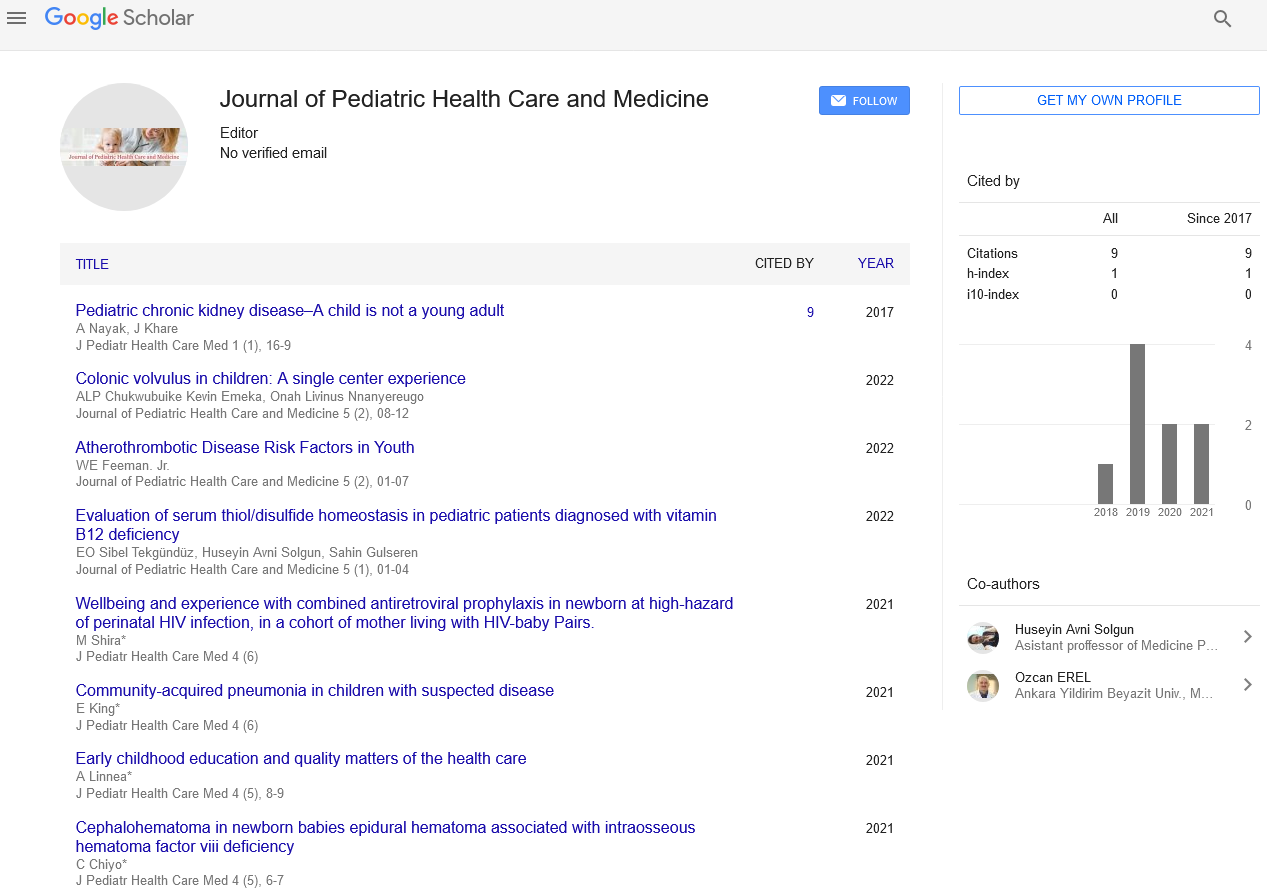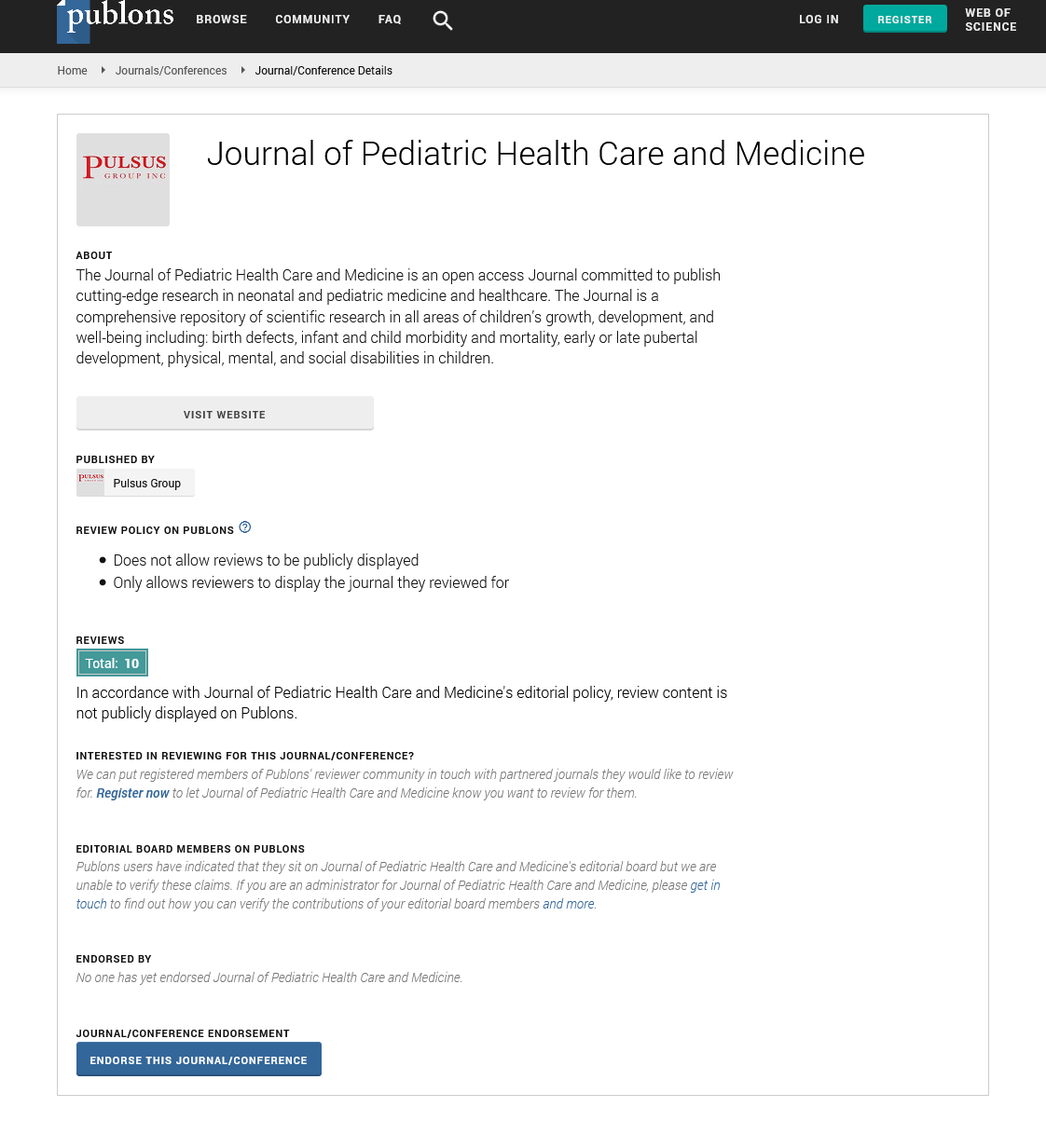Pediatric Vaccination and VaccinePreventable Disease
#Equally contribution
Received: 25-Jun-2021 Accepted Date: Jul 12, 2021; Published: 20-Jul-2021
Citation: None
This open-access article is distributed under the terms of the Creative Commons Attribution Non-Commercial License (CC BY-NC) (http://creativecommons.org/licenses/by-nc/4.0/), which permits reuse, distribution and reproduction of the article, provided that the original work is properly cited and the reuse is restricted to noncommercial purposes. For commercial reuse, contact reprints@pulsus.com
Abstract
This examination explored supplier based correlative/elective medication use and its relationship with receipt of suggested immunizations by kids matured 1–2 years and with obtaining of antibody preventable infection by youngsters matured 1–17 years.
Abstract
This examination explored supplier based correlative/elective medication use and its relationship with receipt of suggested immunizations by kids matured 1–2 years and with obtaining of antibody preventable infection by youngsters matured 1–17 years.
Keywords
Pediatric vaccination, Medicine, Public health
Introduction
Specialists have hailed immunization as one of ten extraordinary Twentieth Century accomplishments in general wellbeing in the United States (US). Pediatric immunizations have drastically decreased irresistible sickness and youth mortality. The US government's "Solid People 2010" drive has defined inclusion objectives for six antibodies suggested for widespread use in small kids [3]. In any case, the proposals are not without contention. A few guardians decide to defer immunizing their youngsters or renounce inoculation out and out for essentially a portion of the designated illnesses. Examination has reliably discovered relationship between parental help for integral and elective medication (CAM) treatments and resistance to pediatric immunization
One exploration bunch detailed a relationship between family utilization of CAM suppliers, especially alignment specialists, and application for nonmedical exceptions from necessary school section inoculations. Another connected parental direction toward elective medication with more prominent worry for incidental effects and a probability of quitting inoculations. Still another found that rulings against pediatric inoculation were more normal among guardians who favored getting immunization data from CAM suppliers rather than ordinary suppliers or general wellbeing specialists. Studies of North American suppliers have revealed blended discoveries with respect to alignment specialists' mentalities toward immunization. A public investigation of US alignment specialists directed during the 1990s tracked down that 66% of respondents concurred that inoculations ought to never be given to babies under 1-year-old.
Practically half accepted the chiropractic calling ought to authoritatively go against the American Public Health Association's inoculation rules. More than 33% accepted that inoculations cause more illness than they forestall, that getting an irresistible infection is more secure than being vaccinated against it, and that there is no logical confirmation that vaccination forestalls sickness. Scientists since that time have kept on recognizing inoculation aversion among bone and joint specialists. In any case, two articles inferred that lone a minority of the chiropractic calling, powered by the compositions of a modest bunch of vocal rivals, holds outrageous enemy of immunization sees. Overviews of understudies and specialists have affirmed that a greater part of the typical offer general help for inoculation and the arrangement of the full range of hazard A 1998 review of Boston family-practice bone and joint specialists tracked down that the larger part gave schooling to guardians however made no express proposal, 30% effectively suggested in favor, and just 7% effectively.
Right now neither the American Chiropractic Association (ACA) nor the International Chiropractors Association (ICA) takes an authority stand in regards to the overall dangers and advantages. The two gatherings go against compulsory inoculation and accentuate the requirement for singular opportunity of decision. The ACA calls for "educated mindfulness regarding the advantages and conceivable unfavorable impacts of inoculation,” though the ICA underscores hazard over advantage. An early examination discovered fundamentally more prominent concurrence with against inoculation articulations among ICA than among ACA individuals. The International Chiropractic Pediatric Association's position is like that of the ICA, zeroing in on unfavorable outcomes. Its fundamental inoculation page stresses hazard.
Proof about relationship among naturopathy and pediatric immunization is less ample, yet distributed reports recommend that solitary a minority of naturopathic doctors effectively support full inoculation. A study of naturopathic doctors in Massachusetts discovered most making no proposal, 20% effectively suggesting, and 7% effectively contradicting pediatric immunization. Questions about inoculation have fixated on a few contentions. First is a conviction that inoculations don't create resistance or that they really cause infection. Second are worries about antibody security, incidental effects and unfriendly occasions, connections to mental imbalance, and general obstruction with fitting improvement of the resistant or sensory systems.
A third contention underscores inclination for disease driven vaccination as more perpetual or safer than antibody incited insurance. Fourth are contentions that limit hazard of sickness procurement or impacts. At long last, some inoculation rivals voice skepticism in favorable to immunization data given by allopathic suppliers, government offices, general wellbeing specialists, and vaccination security and adequacy research. With expanded CAM use in the US during the last 50% of the Twentieth Century, clients' perspectives toward pediatric inoculation have used possibly more noteworthy effect on immunization rates.
Conclusion
Appraisals of pediatric CAM use recommend considerably lower use among youngsters than grown-ups, yet the assessments change generally, contingent on the time of information assortment, time span considered, study plan and test, geographic region, and kinds of CAM included. In a 1996 public selfreport review, less than 2% of guardians detailed utilization of any CAM treatments






